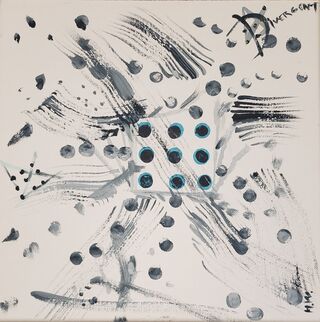Cognition
The Truth About the "Box" in Outside-the-Box Thinking
Unlock your creative mind and unleash your imagination.
Posted June 6, 2020

Innovation consultants advise their clients to “Think outside the box” to boost creativity and adaptability. So, what is this box, and how does one think outside it?
Originally, the box was a reference to the nine-dot problem. The goal of this classic puzzle is simple; Connect all the dots in a 9-dot array using no more than four straight lines and without lifting your pen or pencil from the page. Sound easy? Click here to try the puzzle before you read further.
If this puzzle has you stumped, you’re not alone. The nine equally spaced dots give the impression of a square or box. Without realizing it, you may assume that the lines must be drawn within the boundaries of the dots. To solve the puzzle, you must let go of that assumption—you must think outside the box! In the correct solutions, the lines always extend outside of the square.
In a figurative sense, the "box" is a metaphor for an unnecessary assumption, constraint, or precedent which limits creative problem-solving. Like a literal box, an inflexible representation is restrictive and confining. To overcome this impasse to creative problem solving, it may help to change perspectives, question rules (or assumptions), and try different approaches. In other words, "think outside the box." That may sound intuitive; why do we even need a reminder to think more flexibly?
Shortcuts and Sticky Boxes
For starters, we’re not computers; we take mental shortcuts. We rely on life experience and context to make educated guesses when faced with ambiguous or partial information. In the nine-dot problem, we instantly recognize the pattern of a square, despite the missing lines.
We opt for shortcuts when we have limited time, information, or computational resources; in other words, because we have no alternative. But we also cut corners out of habit. In the words of psychologist Susan Fiske, we are cognitive misers—we spend as little of our cognitive resources as possible.
So, although we quickly interpret situations quickly, we rarely critique the validity of these first impressions. As a result, we may find ourselves confined by our own false assumptions—stuck in the proverbial box. By sticking to what’s allowable, believable, correct, or even possible, we constrain our imagination.
Thinking Outside-the-Box
Innovative thinking emphasizes change. Taking different perspectives, questioning the status quo, thinking unconventionally— these all involve breaking from the norm.
By definition, this sort of thinking is more original. An open and flexible mind also allows one to adapt more easily to unexpected and unprecedented situations.
And best of all, you don’t have to be an innovator or entrepreneur to think outside the box. By embracing little changes, you’ll automatically become more flexible. Here are a couple of simple exercises to stretch your creative muscles in everyday life.
Question assumptions
In the nine-dot problem, you might have limited yourself to solving the puzzle in a certain way because that’s what you thought you were supposed to do. Our assumptions are like internal rules running in the background, outside our awareness, but they are visible in our behavior. Here’s a simple 3-step technique for identifying and breaking your own (imaginary) rules:
- Describe behavior
- Identify assumption
- Break rule
Let’s apply this to the nine-dot problem as an example:
- Behavior: Attempting to connect the dots in a square pattern.
- Assumption: The solution looks like a square (or must stay inside the dots).
- Break rule: Draw something that doesn’t look like a square (or draw outside the dots).
Now let’s try an everyday situation. Imagine you’re trying to fit all your utensils in a drawer and the oddly shaped ones won’t fit.
- You are trying to get all the utensils in the drawer (behavior).
- Utensils belong in a drawer (assumption).
- Utensils don’t have to go in a drawer.
By chucking the unnecessary assumption, you shift your perspective and open yourself to alternative solutions. If you don’t put all the utensils in a drawer, where might you put them instead? Maybe the tall ones could be placed in a funky metal vase… or a glass jar, fun pottery, or sleek organizer. You could hang them from hooks on a rustic wood plank that complements your lake cabin kitchen, etc. Once free of your self-imposed rules, you can creatively improvise.
Break everyday boxes
We are creatures of habit. Think about the things you do on a daily basis (parking, loading the dishwasher, grocery shopping), and ask yourself why you do them that way. Many times the answer is "habit."
Make it a point to try something new or do something differently. Spread a blanket on the living room floor and have a picnic. Swap your desk chair for a stability ball. Take a bath instead of a shower. Take a different jogging path, try a different grocery store, or sample a book from a new genre. Breaking everyday boxes will keep your mind flexible.
Shake it up!
Multi-tasking is a great way to stay flexible. If you’re working at home, take a break from the computer to do laundry. If you have multiple projects, create sub-goals and rotate between tasks. Take a 10-minute walk. Shifting mental gears will refresh your cognitive settings and prevent you from getting stuck in a rut. Set a smartwatch or phone reminder to get moving, take a break, or switch it up. Change can spark creativity!




